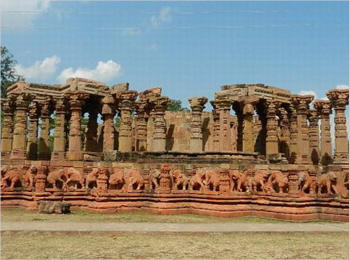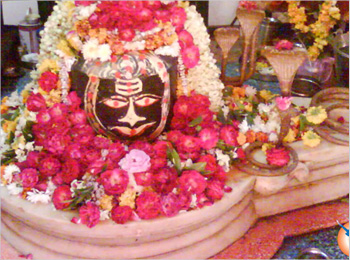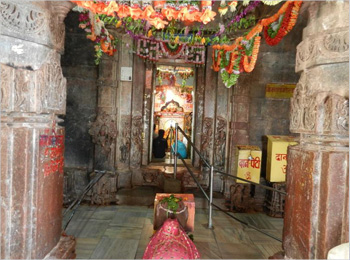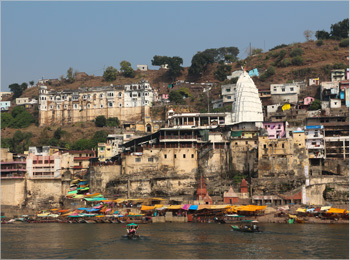- Shiva
Omkareswar Temple
- Indore,Madhya Pradesh
- View on map
- Tell us about this temple
Overview
Omkareshwar is now a developed place as compare to old village type reputation. The place as whole has lot of change and developments are on. Like any other religious place Omkareshwar has markets on the approach roads to all known temples. Ancient Ghats and newly created Ghats for the safety of visitors are here. Two bridges are there to connect the Mandhata and Omkareshwar over Narmada. Many small hotels with low rates are there. The Narmada River, rises in the Amarkantak Plateau of Maikala range in the Shahdol district of Madhya Pradesh at an elevation of 1057 meters above mean sea level at a latitude 22° 40' north and a longitude of 81° 45' east. The river travels a distance of 1,312 km before it falls into Gulf of Cambay in the Arabian Sea near Bharuch in Gujarat. The first 1,079 km of its run are in Madhya Pradesh. In the next length of 35 km, the river forms the boundary between the States of Madhya Pradesh and Maharashtra. Again, in the next length of 39 km, it forms the boundary between Maharashtra and Gujarat. The last length of 159 km lies in Gujarat. The Narmada basin extends over an area of 98,796 sq. km and lies between longitudes 72° 32' E to 81° 45' E and latitudes 21° 20' N to 23° 45' N. The statewise distribution of the drainage area is given in Table 11.1. The catchment area up to Sardar Sarovar dam is 88,000 sq. km. The basin is bounded on the north by the Vindhyas, on the east by the Maikala range on the south by the Satpuras and on the west by the Arabian Sea. Most of the basin is at an elevation of less than 500 meters above mean sea level. A small area around Panchmarhi is at a height of more than 1,000 meters above mean sea level. To a Parikramawasi Narmada becomes the presiding deity. The Parikamawasi salutes and worships her twice a day. Sometimes the parikrama route takes one away from the shore of Narmada because of geographical conditions. In that case carry a bottle of Narmada water and offer prayers to it.
A Parikrama can be started from any point along the banks of Narmada. The whole idea is to return to that point and complete the Parikrama. A Parikravasi walks alongside the Narmada, cannot cross the Narmada, cannot enter more than knee-deep water for a bath, should not dance or swim in its waters. A Parikramawasi shaves the head and beard before undertaking the Parikrama and does not shave till the Parikrama is complete, does not use soap in the waters of Narmada for a bath or for washing clothes, does not spit in Narmada or do an act of disrespect towards Narmada. A Parikramawasi follows bramhacharya (celibacy) during the Parikrama, abstains from lies and wrong deeds, stays quiet, does not criticize others, and behaves with humility and gently with all. For all his needs, including food and shelter, the Parikravasi depends on temples, ashrams, sadhus and people who live on the banks of Narmada. A Parikramavasi walks barefoot, eats whatever food is offered to him, drinks Narmada water, sleeps wherever he can find shelter, carries little money, accepts whatever food or money or clothes are offered to him without a sense of greed or hoarding.
About the Temple

Omkareshwar is Hindu temple situated at a distance of 77 km from Indore. It derives its name from the sacred Hindu symbol of Om. The place is a pilgrimage site, as there are a number of Hindu temples and Jain temples located here. It is basically an island, in the shape of Om, on the confluence of the rivers Narmada and Kaveri. The island is divided into north and south by a deep gully and is linked by a bridge. A boat ride in Narmada River around the island of Omkareshwar is quite enjoyable. Omkareshwara Temple is located at a distance of about 12 miles from Mortakka in Madhya Pradesh. A special feature of the location of Omkareshwar Temple is that the river Narmada branches into two and forms an island Mandhata or Shivapuri in the center. The shape of the island resembles that of the visual representation of the Omkara sound, Om. There are two temples here, one to Omkareshwar and one to Amareshwar. Omkareshwar is considered to be one of the holiest Hindu sites in the nation. This is due to the presence of the Jyotirlingam, one of the twelve in India. Lingam is the symbol of Lord Shiva but the Jyotirlingam is special. Jyotirlingam is called the lingam of light. It is said to derive currents of power from within itself. While, an ordinary lingam is ritually invested with mantra shakti (power invested by chants) by the priests. The Jyotirlingam is enshrined in the Temple of Sri Omkareshwar Mahadeo. Also known as the Temple of Shri Omkar Mandhata, it is made up of locally available soft stone. As a result, there is detailed carving in the front chamber and mesmerizing wall paintings on the upper parts of the structure. Omkareshwar draws hundreds of pilgrims every year from various parts of the nation. The devotees kneel before the Jyotirlinga to be blessed by it. Omkareshwar presents a magnificent blend of natural as well as the human artistry. Apart from this, there are some other temples worth watching. The Siddhnath Temple is a classic example of early medieval Brahminic architecture. The most attractive feature of the temple is the wall paintings of elephants, over 1.5 m high, carved on a stone slab at its outer boundary. The huge Nandi Bull (the vehicle of Lord Shiva) - carved on the hillside opposite the temple of Gauri Somnath, the 24 Avatars and a group of Hindu and Jain temples should not be missed at all. Even the 10th century Satmatrika Temples and the Kajal Rani Cave situated nearby is worth visiting. Omkareshwar lies on the Ratlam-Indore-Khandwa line and the nearest railway station is Omkareshwar Road.
Architectural Style

The Omkareshwar Temple is built in the Nagara style and is characterized by a lofty shikhara. There are also shrines to Annapurna and Ganesha here. Before entering the temple one has to pass through two rooms. The Omkareshwar is not affixed to the ground but is naturally installed there. There is always water around it. The significance of this linga is that the linga is not situated below the cupola. The idol of Lord Shiva is situated on the top of the temple. The temple can be reached by ferry from the banks of the river. A huge fair is organized here on the day of Kartik Poornima.
About The Deity
About the Deity

In ancient times, demons defeated the gods or divines. Indra was worried. The Danavas or Demons have wrecked havoc in all the three worlds, i.e., Trilokas. In order to empower the Devas once again, Lord Shiva assumed the form of Jyotirmaya Omkararoop. He came out of the nether world or Patala. Lord Shankar came out in the form of Linga on the banks of river Narmada. The gods or Devas have worshipped the Linga which made them powerful once again. This time they were able to destroy the demons and re-acquiesced their empire in Heavens. Brahma and Vishnu also lived in the same place as Omkar Amaleshwar. That is why on the banks of Narmada Brahmapuri, Vishnupuri and Rudrapuri are built which are known as Tripuri Kshetra. The Amareshwar JyotiraLinga is situated in Rudrapuri. Later on, in the mythological era or Purana Kala, Yavanaswa Putra Mandhata came into power here with the blessings of Indra. He served Lord Shankara with great devotion. Lord Shankara was pleased with him. The waters of Narmada emanated from the Arghya (holy water) or Jalahari of the Omkar JyotirLinga and flown through the mountains, downward and later on flow unseen. Narmada joins the deep-water spring located near the Linga idol of Omkareshwar. It flows there eternally. When some bubbles appear at the bottom of this spring, it is said, that Lord Shankar is pleased. King Mandhata made this holy place his capital. Therefore, this place is also known as Omkar Mandhata. The descendents of Mandhata live here even today. The Vindhya mountain also performed a severe penance and pleased Omkar-Amareshwar. As a result of which, the whole place turned beautiful. Many hermits like Agastya have performed severe penances and japas at Omkar-Amaleshwaram JyotirLingam. They had built their hermitages. This place of pilgrimage became famous in the historical times too. In 1063 AD, Paramarking Udayaditya installed four stone inscriptions with four Sanskrit Stotras and dedicated them to the Amaleshwar Temple. Pushpadanta’s “Shiva Mahima Stotra” can also be seen as a stone inscription. Initially aboriginals used to live here on Omkareshwar island as a settlement. It belonged to Kalika devi. Devotees of this goddess were known as Bhairavgan and used to harass pilgrims. They used to sacrifice them. After sometime, a saint by the name Dariyayinath took charge of that place and stopped the atrocities of the Bhairavgan. Since then, pilgrims started moving there freely. After that, Bhil reign began there. In 1195 AD, King Bharat Singh Cahuhan won over the Bhils and improved the grandeur of the Omkar Mandhata. Even today the palace ruins of Raja Bahrat Singh Chauhan can be seen. The heirs of Bharat Singh Chauhan call themselves the ‘Kings’ of Omkar island, even now staking their right. The temple was renovated by Peshwa Baji Rao, the second. After Peshwa, Punyashlok Ahilya Devi Holkar, has made several improvements in this ancient shrine. She built strong, expansive and beautiful ghats. The important one among there is the KotirLingarchana schedule.
Form and Characteristics Of The Deity
The Omkareshwar Temple is built in the Nagara style and is characterized by a lofty shikhara. There are also shrines to Annapurna and Ganesha here. Before entering the temple one has to pass through two rooms. The Omkareshwar is not affixed to the ground but is naturally installed there. There is always water around it. The significance of this linga is that the linga is not situated below the cupola. The idol of Lord Shiva is situated on the top of the temple. The temple can be reached by ferry from the banks of the river.
Legend and Stories
The Legends Of Omkareshwar Jyotirlinga Temple
Hindu mythology mentions a violent war that had broken out between the Devas and their evil counterparts, the Asuras. The Asuras had unfortunately defeated them and the powers of the Devas were weakening considerably. The Devas were quite helpless. Seeing no other option of defeating the Asuras, the Devas offered prayers to Lord Shiva. Pleased with their prayers, Lord Shiva in the form of Omkareshwar manifested on earth and defeated the Asuras. Another legend is the story of the Vindhya Mountain, who was once provoked by sage Narada, who teased it that Mount Meru was more important. Vindhya was determined to prove Narada wrong and started observing strict penance with the aim of pleasing Lord Shiva. Lord Shiva was greatly pleased by the devotion of Vindhya and granted him his wish of being greater than Meru. The lingam that was worshipped by Vindhya was split into two on the request of the Gods and sages. One of the lingams is known as Omkareshwar which is located in the Omkareshwar temple on the Shivpuri hills. The other Lingam known as the Mamaleshwar is situated at the opposite bank of the Narmada river. King Mandhata of Ishvaku clan worshipped Lord Shiva here, and the Lord gave him a darshan when he was pleased by his penance. Mandhata’s sons Ambarish and Mucchkund were also great devotees of Lord Shiva and used to perform ritualistic worship of Lord Shiva here. King Mandhata was also the ancestor of Lord Rama.
Omkareshwara Temple, Coorg :
Kings misusing their power is nothing new, neither in our epics, our history, or even the present. Of course, in the present, the kings are replaced by those in power, but, I digress. Getting back to my story, learning of a king committing outrageous acts is nothing new. Leaning that he killed innocent people is nothing new either, and we would scarcely lift an eyebrow. However, when the spirit of the innocent victim plagues the king, we sit up and take note! That is what makes the story of the Omkareshwara Temple in Coorg interesting. It was Lingarajendra II, the ruler of Kodagu in the early 1800s, who killed an innocent Brahmin. The reason for the killing isn’t clear. It is mentioned on a plaque in the temple that the man opposed the king’s misdeeds. I also read in a book that the king coveted the Brahmin’s daughter. Whatever the reason, the king spilt an innocent man’s blood. However, the victim was tenacious, even after death, turning into a Brahmarakshas (spirit) and troubling the king. It was easy for Lingarajendra to kill the Brahmin, but he couldn’t cope with the supernatural, and he turned instead to more Brahmins – learned ones, who told him that the only way he could be rid of the spirit was by getting a special lingam from Kashi (Varanasi) and installing it at the spot where he had killed the Brahmin. That was something the king could do. He arranged for a lingam to be brought from Kashi and installed at the very spot. The temple was built and consecrated in 1820, and, it is said, that the spirit troubled him no more! Interestingly, the temple is built in Islamic style, the dome and minarets towering over the tiled roofs of the city. Inside, the temple is simple, with the shrine holding the main lingam surrounded by one corridor. Opposite the temple is a pond, with a small shrine in the centre, connected by a causeway. There are plenty of fish in the pond, which are a huge attraction for children. It was late evening when we visited, and a puja was just getting completed. There was all the evidence of a busy temple – bells ringing, the sound of chanting, and the hum of the crowd. It was all over in a few moments, and, by the time we went around the sanctum once, we found that we were the only ones there. At once, it seemed we were in a different time and place – there was calm, peaceful, utter silence. Standing there in front of the lingam, I wondered about journeys – my own journey, from Mumbai to Coorg, to see Him, He who had once made the journey from Kashi to Kodagu. My journeys bring me peace and happiness, but His journey had brought peace to someone else. Now, whether he deserved it, is another matter entirely! The temple might have brought some relief to Lingarajendra, but he didn’t live long enough to reap the benefits of the temple. He passed away soon after, and the throne passed to his son, who turned out to be even more cruel than his father. However, the dynasty had little time left in power, for, scarcely 14 years later, in 1834, the British took complete control over Kodagu.
Events / Festivals in Omkareshwar
he festivals in Omkareshwar are celebrated with great delight and religious sentiments .The festivals here are extremely colourful and their celebrations exude a sense of unity and feeling of brotherhood. They celebrate Mahashivratri. “The night of Lord Shiva” or Mahashivratri is the most prominent festival celebrated in reverence of the Lord of the Lords, Shiva. Celebrated on the 13th night of the Phalgun month of Hindu calendar (February-March), the festival marks the devotees of Lord Shiva practicing Yoga and Meditation during the night as these are believed to return unprecedented benefits during the Shivratri night. Fasts are kept during the day and the deity of Lord Shiva is offered milk and other articles during the celebrations. Another festival is Ganesh Chaturthi, which is held in the months of August-September and is one of the famous festivals in Omkareshwar. It is celebrated with immense passion. Anant Chaudas is held in the month of September. On the night of the celebration, major processions are taken out and large idols of Lord Ganesha are engrossed in water. The festival is organized with great passion by the people. Holi, or the “festival of colours” is indeed celebrated in a very colourful manner in Omkareshwar and is one of the biggest festivals for the natives. The atmosphere is really charged up during the celebrations. One of the most important festivals of Hindus, Diwali, is also well known by the name of “Festival of Lights” or Deepavali. It is celebrated in the month of October or November. Diwali in Omkareshwar is celebrated with pomp and show. Goddess Lakshmi is worshiped on this festival.
Accommodation in Omkareshwar
Omkareshwar has many medium to budget accommodation options. Some of the comfortable hotels include Shri Radhe Krishna Resort (Near Omkareshwar temple), Narmada Resort (Omkareshwar), Hotel Geeta Shri & Restaurant (Main Road), Hotel Devansh Palace (Chouke), Hotel Aashirwad (Shiv Kothi), Prasadam Restaurant (Chouke), Hotel Om Shiva (Near New Jhoola Pool) and Maa Kanchan Guest House (Near New Jhoola Pool). The hotels are homely and laced with the modern amenities.
Facts
The island comprises two lofty hills and is divided by a valley in such a way that it appears in the shape of the sacred Hindu symbol 'Om' from above. Between the precipitous hills of the Vindhya on the North and the Satpura on the South, the Narmada forms a deep silent pool which in former times was full of alligators and fish, so tame as to take grain from human hand. This pool is 270 ft below the cantilever type bridge constructed in 1979. The bridge has enhanced the scenic beauty of the place, making it look exceedingly picturesque.
Near By Places
The places nearby include the Panchmukhi Ganesh Temple, Mamleshwar Temple, the Vrahadeshwar temple, the Govindeshwar temple and cave, the Annapoorna temple, the Mahakaeshwar temple, the Gurudwara, the Shri Dada Darbar khandwa, the Siddhawar koot, Maheshwar, Burhanpur and Mandu.
Accessibility
Indore is well connected with the whole of India by road, rail as well as air transport services. Indore is also a tourist destination due to which the city has proper transport channels. For the convenience of the visitors there are regular services of bus, train and flights.Indore is fairly well connected to different parts of Madhya Pradesh as well as India.
Road
There are a number of National and State Highways passing from Indore namely, NH3, NH69, 69A, NH86. This makes the place very accessible. The city is connected to all the major and minor cities nearby, via proper roads. There are bus services to and from Indore to facilitate traveling. The prominent cities linked to Indore by road are Bhopal, Barwani, Khandwa, Ujjain, Dewas, Dhar, Ratlam, Khargoan, Jhabua and Agar. Indore lies on the longest functional meter gauge line in India, i.e. between Jaipur and Purna.
Rail
The railway station of the city falls under the Ratlam division of Western Railways. Indore is one of the few places in India where both meter gauge and broad gauge railways tracks operate. An interesting feature of these lines is that they intersect each other forming a Diamond crossing. Indore is well connected to all parts of the country including the four metros. There are a few direct trains to Mumbai, Delhi, Kolkata (Howrah) and Chennai. Though the number of trains is less, Indore has train services to other major towns like Trivandrum, Ahmedabad, Pune, Jammu, Jaipur, Lucknow, Bhopal, Nagpur, Patna etc. There are four stations within the city, namely Rajendra Nagar, Lokmanya Nagar, Saifee Nagar and Lakshmibai Nagar. They even run short distance trains connecting Indore to nearby towns and villages.
Air
The Devi Ahilyabai Holkar Airport in Indore connects it to most of the major cities in the country. It is directly linked to Mumbai, Delhi, Ahmedabad, Hyderabad, Kolkata, Jaipur, Raipur, Nagpur and Bhopal, via major airlines. There are various airlines operating from Indore. These include Indian Airlines, Jet Airways, Air Sahara, Kingfisher Airlines and Deccan Aviation. Indore airport has good infrastructure and facilities. It is proposed to give it international status soon.
Temple Address
Shri Omkareshwar Jyotirlinga
Khandwa, ShivPuri, Indore
Madhya Pradesh
India,Pincode - 450554
Significance
Devotees visit this temple to seek fulfillment of the following:-
- Mandhata was a great Emperor of the Ishvaku clan who ruled this land. He did great penance in this land and there is an ashram called Mandhata ashram here. This spiritual and all powerful jyotirlinga of Lord Shiva is at Ujjain in Madhya Pradesh. There Lord Shiva came in the form of Mahakal out of the linga that split and killed the demon. Therefore all those who pray to this linga will never fear death and if their faith is true they will be out of the chakra of life and death.
Shlokas
Kailaasarana Shiva Chandramouli Phaneendra Maathaa Mukutee Zalaalee Kaarunya Sindhu Bhava Dukha Haaree Thujaveena Shambho Maja Kona Taaree
Meaning -Oh Lord Shiva who is seated on Mount Kailash, where the moon decorates his forehead and the king of serpents crown his head, who is merciful and removes delusion, You alone can protect me. I surrender to thee.
Aum Trayambakam Yajaamahey Sugandhim Pusti Vardhanam Urvaarukamiva Bandhanaath Mrutyor Muksheeya Maamritaat
Meaning -We worship the fragrant Lord Shiva, who has 3 eyes and who cultivates all beings. May He free me from death, for immortality, as even a cucumber is separated from its bond with the vine.
Timings
All days of the week 5:00 AM - 10:00 PM
